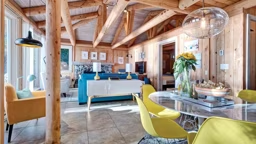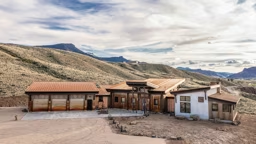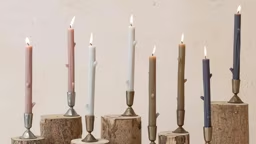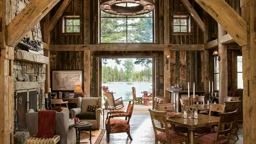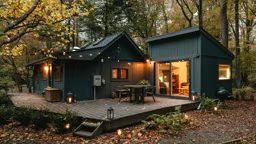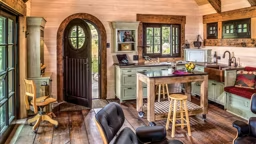• Hopper Windows – are hinged at the bottom and open inward. Screens are placed on the exterior of the window unit. Similar to casements, as the entire window area can be opened. Suitable for deck or walkway areas, but you will want to make sure they don’t interfere with traffic areas inside your cabin.
• Single and Double Hung Windows – are double-hung units; both sashes slide vertically. Only the bottom sash slides upward in a single-hung window. Ventilation area can vary from a small crack to an opening of one-half the total glass area. Screens can be placed on the exterior or interior of the window unit. These types of windows work well in high-traffic areas.
• Slider Windows – are models in which both sashes slide horizontally in a double-sliding window. Only one sash slides in a single-sliding window. A major advantage: The flexible ventilation area can vary from a small crack to an opening of one-half the total glass area. Screens can be placed on the exterior or interior of the window unit. Like single and double-hung windows, sliders don’t interfere with traffic inside or outside.
Breaking it Down
• Casement Windows – are hinged at the side. Casement windows project outward, providing significantly better ventilation than sliders of equal size. Because the sash protrudes from the plane of the wall, it can be controlled to catch passing breezes, but screens must be placed on the interior side. Virtually the entire casement window area can be opened, while sliders are limited to less than half of the window area. However, you may not want to install these windows over a deck
or walkway where they can interfere with traffic patterns.
• Casement Windows – are hinged at the side. Casement windows project outward, providing significantly better ventilation than sliders of equal size. Because the sash protrudes from the plane of the wall, it can be controlled to catch passing breezes, but screens must be placed on the interior side. Virtually the entire casement window area can be opened, while sliders are limited to less than half of the window area. However, you may not want to install these windows over a deck
or walkway where they can interfere with traffic patterns.
• Awning Windows – are hinged at the top and open outward. Screens are placed on the interior
of the window unit. Similar to casements, the entire window area can be opened. Be wary near walkways and decks.
of the window unit. Similar to casements, the entire window area can be opened. Be wary near walkways and decks.
• Skylights and Roof Windows – are actually two different things. Skylights, which are installed in out-of-reach applications, are mostly permanently fixed in place, mounted on a curb above a flat or sloped roof. Roof windows are installed in places where they are accessible.
Operable skylights and roof windows that can be opened by hand – with an extended crank or remote control motor – are becoming increasingly more common. The beauty of this:?You can allow hot air that rises to the ceiling level to be exhausted from your cabin. This can be a big relief to those sleeping in loft areas!
Roof windows and skylights are available with most of the glazing options of standard windows and can be equipped with operable interior shading systems.
You can mix all different types of windows throughout your place. The key is to thoughtfully balance your aesthetic preferences with your energy-saving goals, ventilation needs and traffic constraints.
Nils Petermann is a senior research associate for the Efficient Windows Collaborative, a project by the Alliance to Save Energy.
Operable skylights and roof windows that can be opened by hand – with an extended crank or remote control motor – are becoming increasingly more common. The beauty of this:?You can allow hot air that rises to the ceiling level to be exhausted from your cabin. This can be a big relief to those sleeping in loft areas!
Roof windows and skylights are available with most of the glazing options of standard windows and can be equipped with operable interior shading systems.
You can mix all different types of windows throughout your place. The key is to thoughtfully balance your aesthetic preferences with your energy-saving goals, ventilation needs and traffic constraints.
Nils Petermann is a senior research associate for the Efficient Windows Collaborative, a project by the Alliance to Save Energy.
There are a large variety of window types you can consider for your cabin. Factors such as appearance and view, thermal comfort, energy-performance and ventilation all play a role in your choices. Of course, your cabin’s design and your personal tastes will dictate which window size, shape and frame type offer the best appearance, daylight and view.
Following is an overview of some window options that can help you make an informed decision that takes aesthetic, as well as long-term energy and maintenance considerations into account.
Energy Efficiency &Thermal Comfort
Just by looking at a window you can’t necessarily see whether it will keep you warm in the winter and keep intense solar heat out in the summer. So the U.S. Department of Energy and the Environmental Protection Agency have developed the ENERGY STAR label to help you choose the appropriate windows for your climate. For more detailed information, consult the website of the Efficient Windows Collaborative (www.efficientwindows.org), which includes a Window Selection Tool for different climates across the U.S. and Canada.
Window Types
When you select a window, there are numerous types to consider.
Fixed (or picture) windows have two main advantages: Their large glass areas enhance light and view, and they leak only minimal amounts of air if installed correctly. However, to provide ventilation and egress (an escape route), fixed windows need to be combined with operable windows.
Traditional operable window types include the hinged types such as casement, awning and hopper. These windows swing outward or inward. Operable windows also include sliding types such as double- and single-hung and horizontal sliding. Hinged windows generally have lower air leakage rates than sliding windows from the same manufacturer because a compressive latch increases the effectiveness of the weather-stripping when the sash closes by pressing against the frame.
Following is an overview of some window options that can help you make an informed decision that takes aesthetic, as well as long-term energy and maintenance considerations into account.
Energy Efficiency &Thermal Comfort
Just by looking at a window you can’t necessarily see whether it will keep you warm in the winter and keep intense solar heat out in the summer. So the U.S. Department of Energy and the Environmental Protection Agency have developed the ENERGY STAR label to help you choose the appropriate windows for your climate. For more detailed information, consult the website of the Efficient Windows Collaborative (www.efficientwindows.org), which includes a Window Selection Tool for different climates across the U.S. and Canada.
Window Types
When you select a window, there are numerous types to consider.
Fixed (or picture) windows have two main advantages: Their large glass areas enhance light and view, and they leak only minimal amounts of air if installed correctly. However, to provide ventilation and egress (an escape route), fixed windows need to be combined with operable windows.
Traditional operable window types include the hinged types such as casement, awning and hopper. These windows swing outward or inward. Operable windows also include sliding types such as double- and single-hung and horizontal sliding. Hinged windows generally have lower air leakage rates than sliding windows from the same manufacturer because a compressive latch increases the effectiveness of the weather-stripping when the sash closes by pressing against the frame.






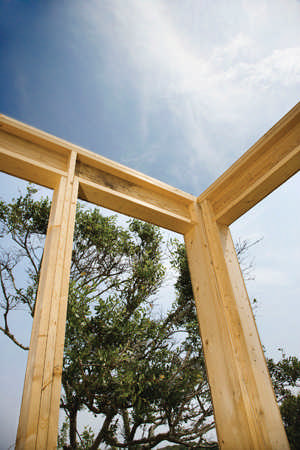 Jupiterimages
Jupiterimages 


